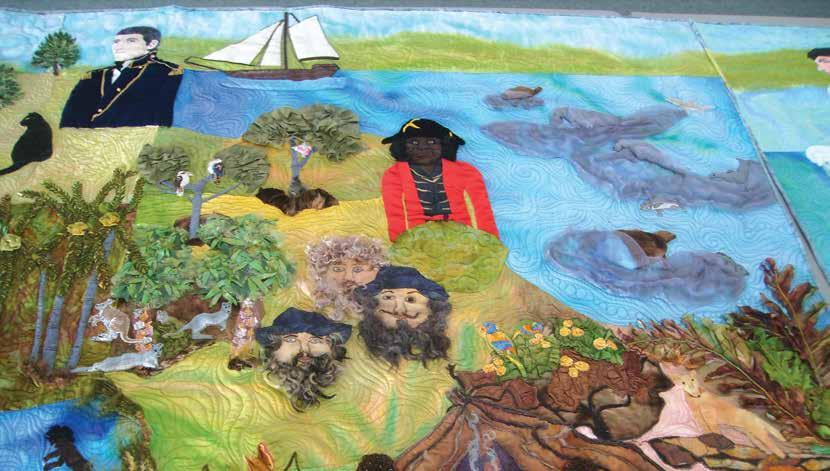HISTORY Detail of History Quilt by Valmay Bell
BRIBIE ISLAND -
A Handy History I would like to thank the many people who tell me how much they enjoy reading these regular articles about Bribie history. I had no prior interest in History before retiring to Bribie after an International career living and working in many countries. I soon discovered fascinating facts about my new island home and the significance to Queensland and Australian heritage. I write these articles to share interesting facts with more people, and our Handy History book is available at the Museum and Post Office for just $10 if you want more. This article might answer some of the questions I am frequently asked.
1845, may well incorporate traces of these various spellings and pronunciations. Tom Petrie, whose family were
EXPLORERS & VISITORS
NAMING OF BRIBIE ISLAND. Many people have a slightly different story about this, most of which are a long way from the known facts, although the actual answer is “Nobody really knows” Documents and Maps from as early as 1830 show different spellings of a “Brieby’s”, “Brady’s” and “Bribey’s” island. After establishing Moreton Bay Penal Settlement in 1824, and the new town of Brisbane, references are made to a “Brisbane” Island in the bay. The final name “Bribie”, recorded for the first time in
titled “Bribie the Basket Maker”, a romantic tale of a convict who escaped and fell in love with an aboriginal woman on the island, settled, and lived happily ever after. This was total fiction, and Welsby himself admits there is no record of a person named Bribie in any of the Moreton Bay records. Research continues, and more evidence may yet become known, but the honest answer to the question “How did Bribie Island get its name” remains unanswered to this day.
pioneer settlers in Brisbane in 1837, in his reminiscences to his daughter in 1904, he remembered a vague second-hand account he had heard from his father Andrew Petrie, more than 60 years earlier, about a convict by the name of Bribie who had fled to the island. More than 30 years later in 1937, businessman and author Thomas Welsby picked up this flimsy thread and wrote a book
42 www.thebribieislander.com.au
The Bribie Islander
When James Cook sailed along this coastline in 1770 he saw through his telescope the far away mountains he named the “Glasshouses”, being reminiscent of Glass Factories in his far-distant home. When Mathew Flinders and his aboriginal companion Bongaree came to explore this Bay almost 30 years later in 1799, he was the first European to set foot on what is now Bribie Island and climbed a Glasshouse mountain. He named Pumicestone river but did not know it was an island. It was another 60 years before Queensland became a new Colony, separated from NSW in 1859.
By Barry Clark Bribie Island Historical Society In those 60 years, there were very few who came to this desolate Island. After Flinders and Bongaree in 1799, the first white men came by chance 24 years later, when three convicts lost in a huge storm out of Sydney, were washed up weeks later on Moreton Island. They were very lucky to be alive at all, and with help from various local tribes, they found their way around the bay to live for many months on this island before being rescued. They thought they had been washed ashore south of Sydney and each spent many weeks walking north in the hope of reaching Sydney, but finding nothing they returned to the care of the island people. Those who came seeking a site for a new Penal Colony in Moreton Bay found these castaway convicts the following year. Some of the worst convicts from Sydney were sent to a new Penal Settlement at Redcliffe in 1824, which relocated after few months to the site of Brisbane on the river. Within a hundred years of the first sighting of these shores by Captain Cook, the once extensive Aboriginal population of Moreton Bay had been dramatically reduced. This led to the establishment of








